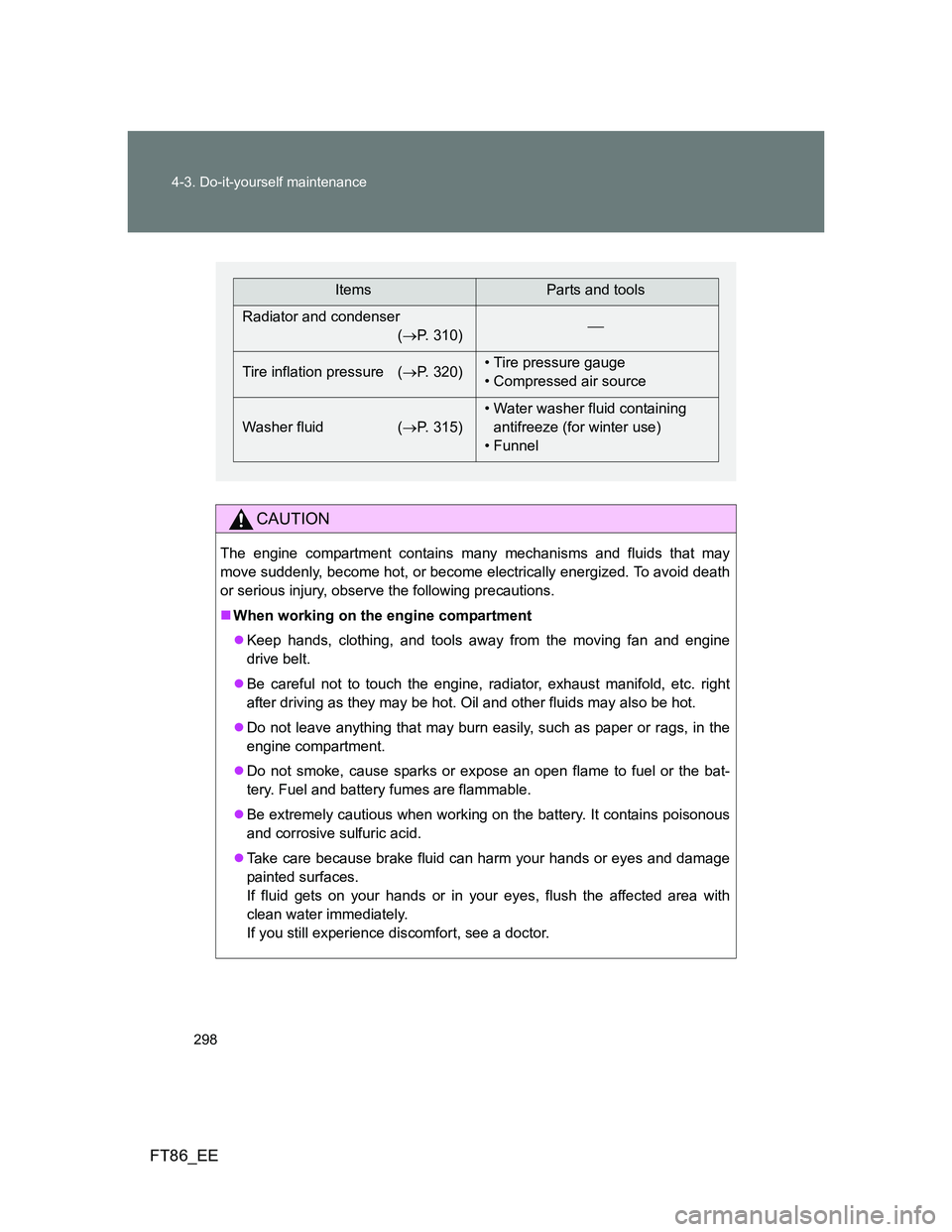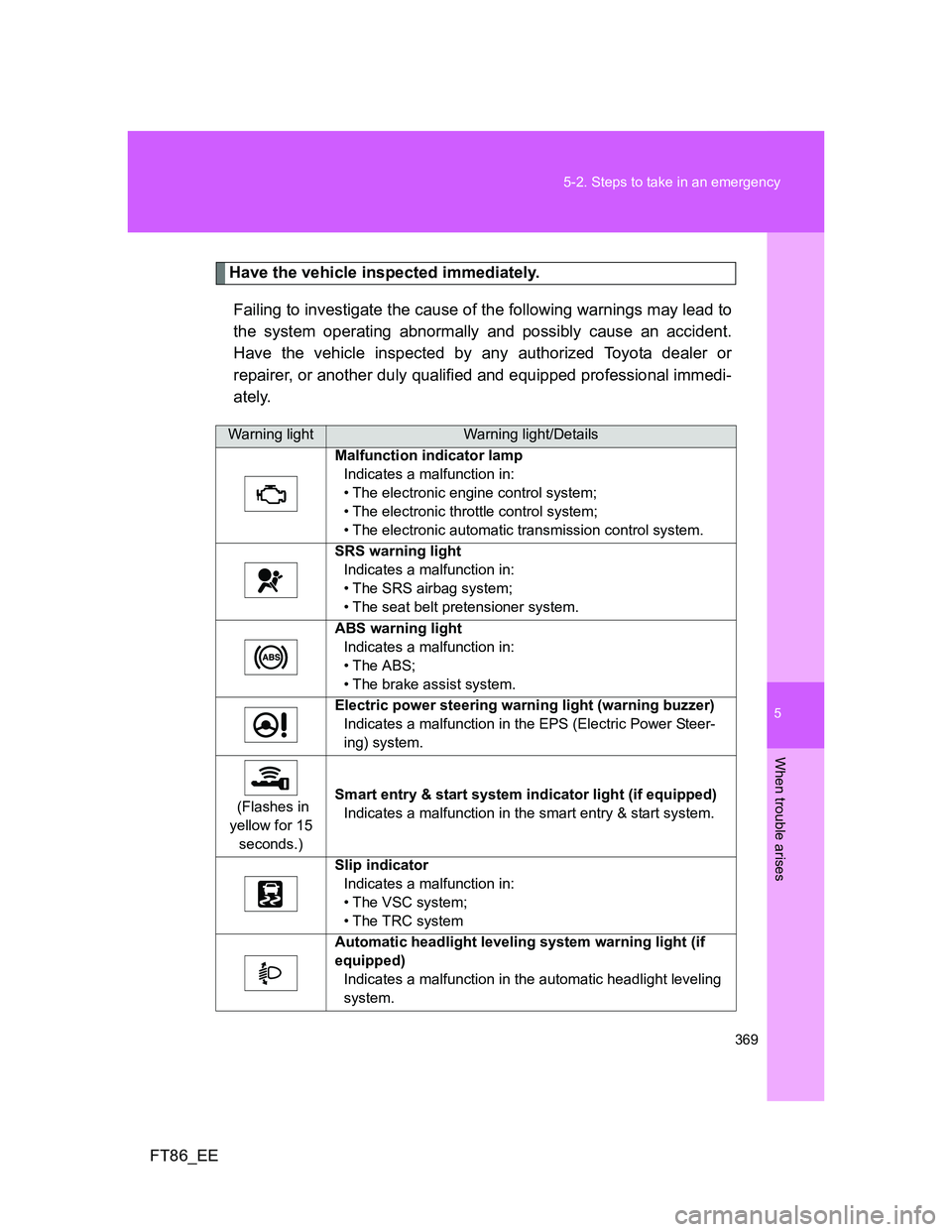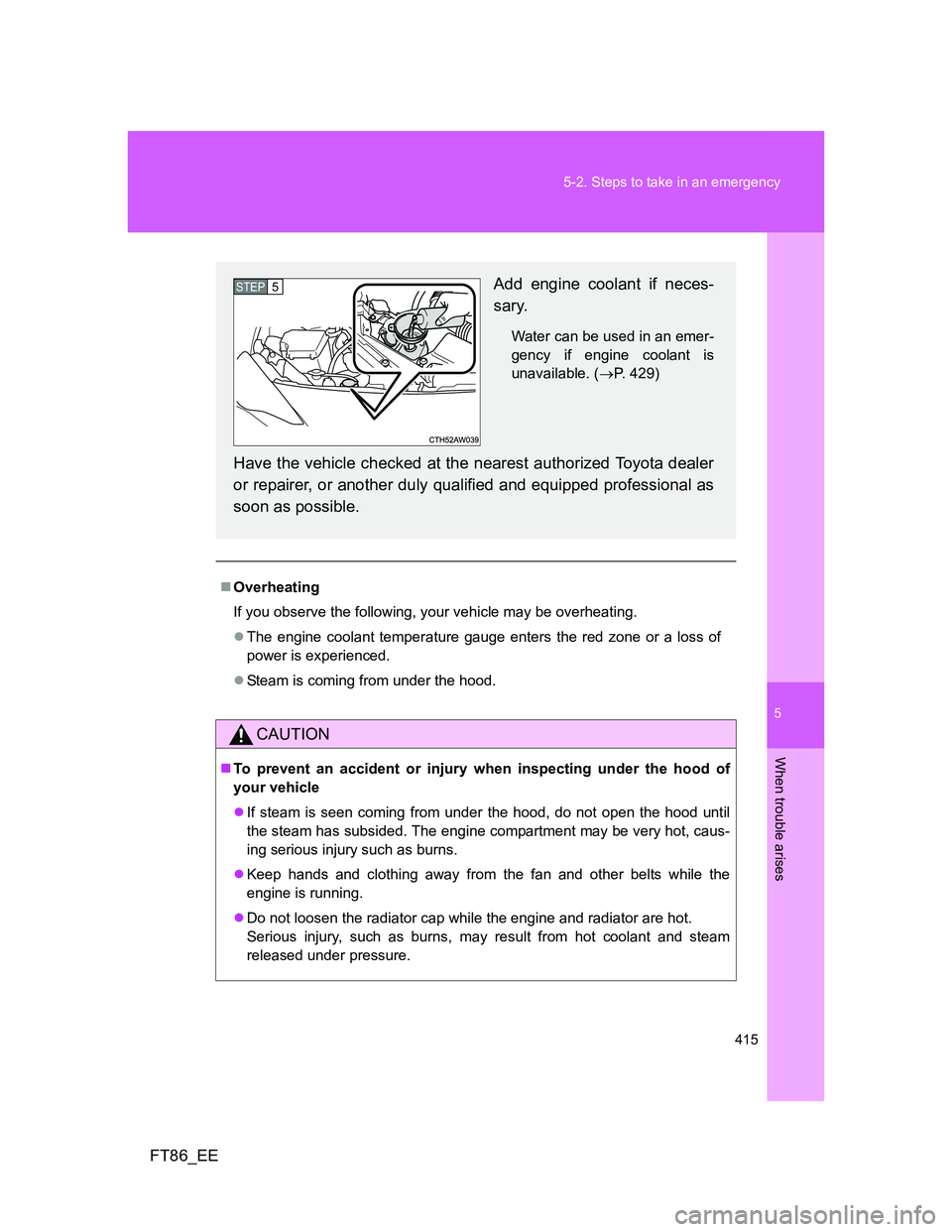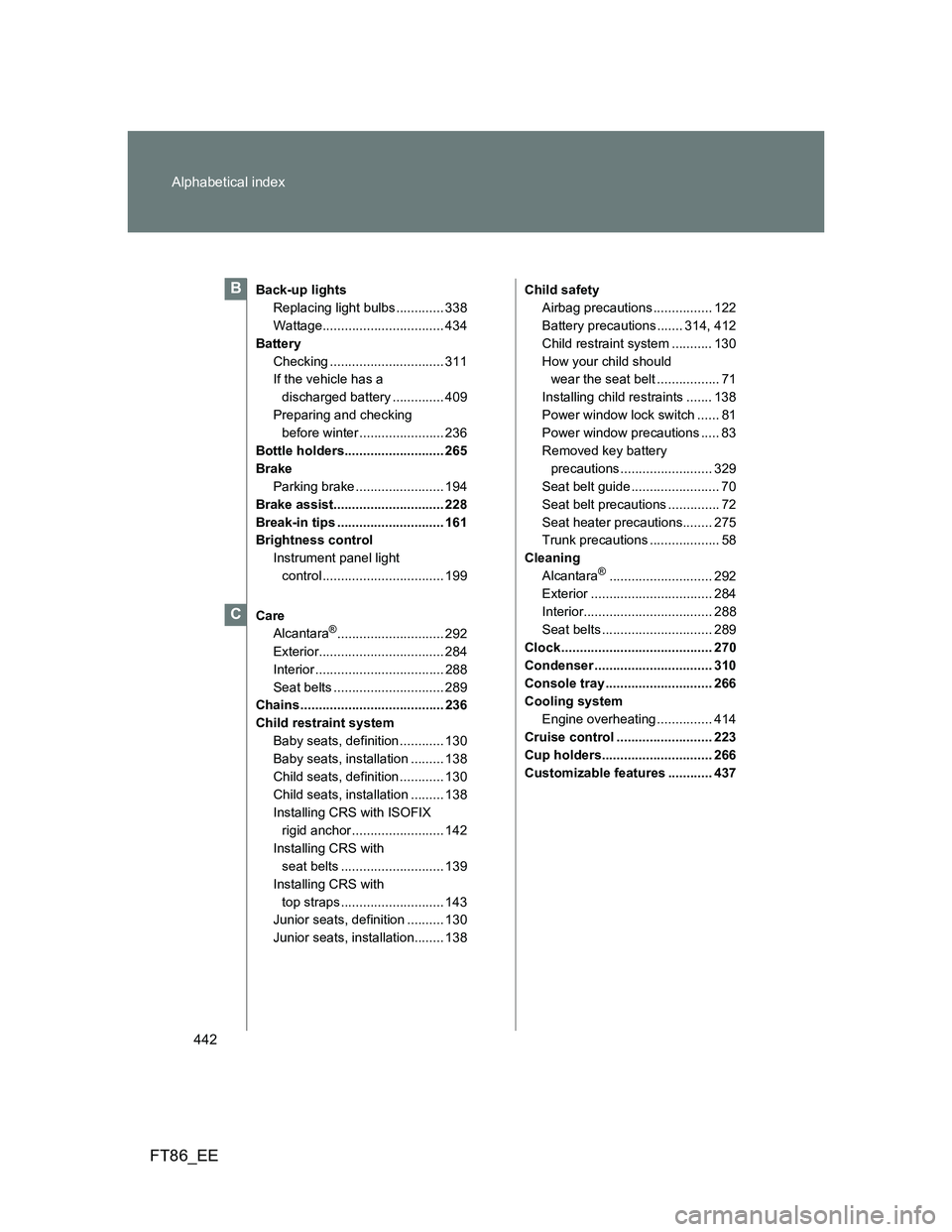Page 298 of 452

298 4-3. Do-it-yourself maintenance
FT86_EE
CAUTION
The engine compartment contains many mechanisms and fluids that may
move suddenly, become hot, or become electrically energized. To avoid death
or serious injury, observe the following precautions.
When working on the engine compartment
Keep hands, clothing, and tools away from the moving fan and engine
drive belt.
Be careful not to touch the engine, radiator, exhaust manifold, etc. right
after driving as they may be hot. Oil and other fluids may also be hot.
Do not leave anything that may burn easily, such as paper or rags, in the
engine compartment.
Do not smoke, cause sparks or expose an open flame to fuel or the bat-
tery. Fuel and battery fumes are flammable.
Be extremely cautious when working on the battery. It contains poisonous
and corrosive sulfuric acid.
Take care because brake fluid can harm your hands or eyes and damage
painted surfaces.
If fluid gets on your hands or in your eyes, flush the affected area with
clean water immediately.
If you still experience discomfort, see a doctor.
ItemsParts and tools
Radiator and condenser
(P. 310)
Tire inflation pressure (P. 320)• Tire pressure gauge
• Compressed air source
Washer fluid (P. 315)• Water washer fluid containing
antifreeze (for winter use)
• Funnel
Page 369 of 452

5
369 5-2. Steps to take in an emergency
When trouble arises
FT86_EE
Have the vehicle inspected immediately.
Failing to investigate the cause of the following warnings may lead to
the system operating abnormally and possibly cause an accident.
Have the vehicle inspected by any authorized Toyota dealer or
repairer, or another duly qualified and equipped professional immedi-
ately.
Warning lightWarning light/Details
Malfunction indicator lamp
Indicates a malfunction in:
• The electronic engine control system;
• The electronic throttle control system;
• The electronic automatic transmission control system.
SRS warning light
Indicates a malfunction in:
• The SRS airbag system;
• The seat belt pretensioner system.
ABS warning light
Indicates a malfunction in:
• The ABS;
• The brake assist system.
Electric power steering warning light (warning buzzer)
Indicates a malfunction in the EPS (Electric Power Steer-
ing) system.
(Flashes in
yellow for 15
seconds.)Smart entry & start system indicator light (if equipped)
Indicates a malfunction in the smart entry & start system.
Slip indicator
Indicates a malfunction in:
• The VSC system;
• The TRC system
Automatic headlight leveling system warning light (if
equipped)
Indicates a malfunction in the automatic headlight leveling
system.
Page 371 of 452

5
371 5-2. Steps to take in an emergency
When trouble arises
FT86_EE
Follow the correction procedures.
After taking the specified steps to correct the suspected problem,
check that the warning light turns off.
Warning lightWarning light/DetailsCorrection procedure
Open door warning light
Indicates that a door or the
trunk is not fully closed.Check that both side doors
and the trunk are closed.
Low fuel level warning
light
Remaining fuel
(Approximately 7.0 L
[1.8 gal., 1.5 Imp. gal.] or
less)Refuel the vehicle.
(On the instru-
ment cluster)Driver’s seat belt
reminder light
(warning buzzer)*
Warns the driver to fasten
his/her seat belt.Fasten the seat belt.
(On the center
panel)Front passenger’s seat
belt reminder light
(warning buzzer)*
Warns the front passenger
to fasten his or her seat
belt.Fasten the seat belt.
Automatic transmission
fluid temperature warning
light (if equipped)
Indicates that the auto-
matic transmission fluid
temperature is too high.Stop the vehicle in a safe
place and shift the shift lever
to P.
If the light goes off after a lit-
tle while, the vehicle can be
driven. If the light does not
go off, contact any autho-
rized Toyota dealer or
repairer, or another duly
qualified and equipped pro-
fessional.
Page 372 of 452
372 5-2. Steps to take in an emergency
FT86_EE
*: Driver's and front passenger’s seat belt buzzer:
The driver’s and front passenger’s seat belt buzzer sounds to alert the driver
and front passenger that his or her seat belt is not fastened. The buzzer
sounds for 30 seconds after the vehicle has reached a speed of at least 20
km/h (12 mph). Then, if the seat belt is still unfastened, the buzzer will sound
in a different tone for 90 more seconds.
Front passenger detection sensor and passenger seat belt reminder
and warning buzzer
If luggage is placed on the front passenger seat, the front passenger
detection sensor may cause the warning light to flash and warning
buzzer to sound, even if a passenger is not sitting in the seat.
If a cushion is placed on the seat, the sensor may not detect a passen-
ger, and the warning light may not operate properly.
Page 413 of 452
5
413 5-2. Steps to take in an emergency
When trouble arises
FT86_EE
CAUTION
To prevent damage to the vehicle
Do not pull- or push-start the vehicle as the three-way catalytic converter
may overheat and become a fire hazard.
NOTICE
When handling jumper cables
Be careful that the jumper cables do not become tangled in the cooling fans
or any of the belts when connecting or disconnecting them.
When closing the doors
While pushing the door glass towards the inside of the vehicle, slowly close
the door.
Because the side window open/close function linked to door operation will
not operate, the window may interfere with the vehicle body, possibly
scratching both the vehicle body and window, or even shattering the window.
Page 415 of 452

5
415 5-2. Steps to take in an emergency
When trouble arises
FT86_EE
Overheating
If you observe the following, your vehicle may be overheating.
The engine coolant temperature gauge enters the red zone or a loss of
power is experienced.
Steam is coming from under the hood.
CAUTION
To prevent an accident or injury when inspecting under the hood of
your vehicle
If steam is seen coming from under the hood, do not open the hood until
the steam has subsided. The engine compartment may be very hot, caus-
ing serious injury such as burns.
Keep hands and clothing away from the fan and other belts while the
engine is running.
Do not loosen the radiator cap while the engine and radiator are hot.
Serious injury, such as burns, may result from hot coolant and steam
released under pressure.
Add engine coolant if neces-
sary.
Water can be used in an emer-
gency if engine coolant is
unavailable. (P. 429)
Have the vehicle checked at the nearest authorized Toyota dealer
or repairer, or another duly qualified and equipped professional as
soon as possible.
STEP 5
Page 425 of 452
425 6-1. Specifications
6
Vehicle specifications
FT86_EE
Engine
Fuel
*: If unleaded gasoline with an octane rating of 98 RON is not available,
unleaded gasoline with an octane rating of 95 RON may be used with no
detriment to engine durability or driveability.
Model FA20
Ty p eHorizontally opposed, liquid cooled 4 cylinder, 4-
stroke gasoline
Bore and stroke 86.0 86.0 mm (3.39 3.39 in.)
Displacement 1998 cm3 (121.93 cu.in.)
Drive belt tension Automatic adjustment
Fuel typeEU area:
Unleaded gasoline conforming to European stan-
dard EN228 only
Except EU area:
Unleaded gasoline only
Research octane num-
ber98 or higher*
Fuel tank capacity
(Reference)50 L (13.2 gal., 11.0 Imp. gal.)
Page 442 of 452

442 Alphabetical index
FT86_EE
Back-up lights
Replacing light bulbs ............. 338
Wattage................................. 434
Battery
Checking ............................... 311
If the vehicle has a
discharged battery .............. 409
Preparing and checking
before winter ....................... 236
Bottle holders........................... 265
Brake
Parking brake ........................ 194
Brake assist.............................. 228
Break-in tips ............................. 161
Brightness control
Instrument panel light
control ................................. 199
Care
Alcantara
®............................. 292
Exterior.................................. 284
Interior ................................... 288
Seat belts .............................. 289
Chains ....................................... 236
Child restraint system
Baby seats, definition ............ 130
Baby seats, installation ......... 138
Child seats, definition ............ 130
Child seats, installation ......... 138
Installing CRS with ISOFIX
rigid anchor ......................... 142
Installing CRS with
seat belts ............................ 139
Installing CRS with
top straps ............................ 143
Junior seats, definition .......... 130
Junior seats, installation........ 138Child safety
Airbag precautions ................ 122
Battery precautions ....... 314, 412
Child restraint system ........... 130
How your child should
wear the seat belt ................. 71
Installing child restraints ....... 138
Power window lock switch ...... 81
Power window precautions ..... 83
Removed key battery
precautions ......................... 329
Seat belt guide ........................ 70
Seat belt precautions .............. 72
Seat heater precautions........ 275
Trunk precautions ................... 58
Cleaning
Alcantara
®............................ 292
Exterior ................................. 284
Interior................................... 288
Seat belts .............................. 289
Clock ......................................... 270
Condenser ................................ 310
Console tray ............................. 266
Cooling system
Engine overheating ............... 414
Cruise control .......................... 223
Cup holders.............................. 266
Customizable features ............ 437
B
C